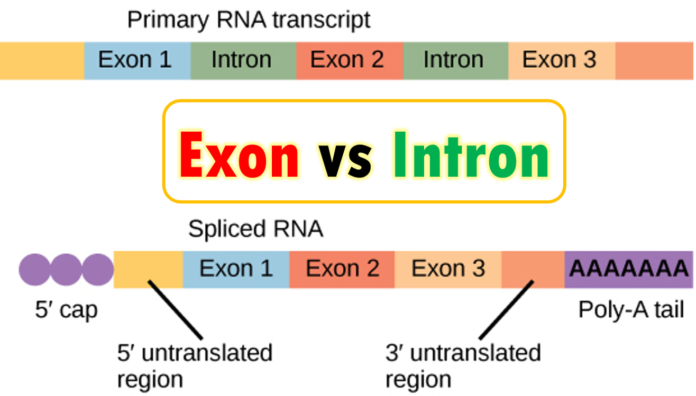Introduction
Exon and Cistron are regions of DNA that play roles in protein synthesis. Understanding the difference between exon and cistron is crucial. While they are related to each other, they serve distinct functions in the genetic code. The difference between exon and cistron is important in genetics and molecular biology:
- It allows researchers to identify and study the various regions of a gene. This is then, used to understand how they contribute to the final protein product.
- Mutations in either exons or cistrons can lead to genetic disorders or diseases. So understanding these regions is important for diagnosing and treating such conditions.
- The discovery of the intron-exon structure of genes was a breakthrough in biology. It has helped us better understand how genes are regulated. It has also helped us understand how genetic information is expressed.
What is an exon?
Exons are one of the two main types of sequences found in genes, the other being introns. Exons are the coding sequences within a gene that are transcribed into mRNA. This is then translated into proteins. Understanding Exons is essential for deciphering the difference between exons and cistrons. Here are some important points to keep in mind when it comes to exons:
- Exons are the segments of a gene that contain the information necessary to code for proteins.
- They make up only a small portion of the total length of a gene. The majority of a gene is made up of non-coding introns.
- Exons are spliced together in a specific order during the process of mRNA maturation. This involves removing the introns.
- The molecule is transported into the cytoplasm to be translated into proteins.
- The sequence within a gene determines the order of amino acids added during protein synthesis.
- Mutations that affect the sequence of exons can alter the resulting protein. Potentially leading to genetic disorders.
- The number of exons in a gene can vary widely between species. Some genes contain a single exon and others contain hundreds or even thousands.
What is a cistron?
A cistron, also known as a gene, is a sequence of DNA that encodes a functional RNA or protein product. The term “cistron” was coined by Seymour Benzer in 1957. It describes a genetic unit that determines a single functional unit of a protein. While both exons and cistrons are in the code, there is a difference between exons and cistrons. Here are some key points to understand about cistrons:
- A cistron is the basic unit of genetic information and it is a segment of DNA that codes for a specific protein or RNA molecule.
- The sequence of nucleotides in a cistron determines the sequence of amino acids in a protein. It even determines the sequence of bases in a molecule.
- The expression of a cistron is tightly regulated. That means that it is only transcribed and translated when needed by the cell.
- Mutations can lead to genetic diseases or changes in the phenotype of an organism.
- Cistrons can be located on different chromosomes or on the same chromosome. They can also be arranged in tandem or in clusters.
- The term “cistron” is often used interchangeably with “gene”. Although there are some technical differences between the two terms.
Difference Between Exon And Cistron
Exons and cistrons are both important, but they refer to different parts of the genetic code. Here are the key differences between exon and cistron:
- They play their roles and it’s important to know the difference between exon and cistron. Both terms relate to the structure of genes and RNA. Yet, they refer to different parts of the genetic code and serve different purposes.
- An exon is a specific part of a gene, while a cistron refers to the entire coding region of a gene.
- Exons are the portions of genes that code for proteins. While cistrons can include both coding and non-coding regions of DNA.
- Exons are separated by introns, while cistrons are not.
Similarities Between Exon And Cistron
The difference between exon and cistron is essential for knowing genes’ relation to physical traits. Yet, the similarities must not be understated.
- Both terms relate to the structure of genes and how they are expressed.
- They are both important to the genetic code and the physical traits of an organism.
- Both terms are related to RNA and its role in gene expression.
Examples of exons and cistrons
Examples of Exons:
- The human insulin gene consists of three exons.
- The dystrophin gene is associated with the genetic disorder Duchenne muscular dystrophy. It has 79 exons that code for a large protein important for muscle function.
- The BRCA1 gene is linked to hereditary breast and ovarian cancer. It has 24 exons that code for a protein involved in DNA repair.
Examples of Cistrons:
- The lac operon in bacteria consists of three cistrons. This is responsible for the production of enzymes involved in lactose metabolism.
- The tryptophan operon in bacteria consists of five cistrons. These work together to produce the amino acid tryptophan.
- The human β-globin gene consists of three cistrons. These encode the three types of globin chains found in haemoglobin.
FAQs
Q1: Are all cistrons transcribed into RNA?
Ans. No, not all cistrons are transcribed, as some may be regulatory regions or introns.
Q2: How does alternative splicing affect the number of exons in a mature mRNA molecule?
Ans. It can result in combinations of exons being included in the molecule.
Q3: Are all exons the same length?
Ans. No, exons can vary in length from a few nucleotides to several thousand nucleotides.
Q4: Can cistrons overlap with each other in a genome?
Ans Yes, it is possible for cistrons to overlap with each other in a genome.
Q5: Are all exons translated into protein?
Ans. No, some may be untranslated regions important for the regulation of gene expression.
